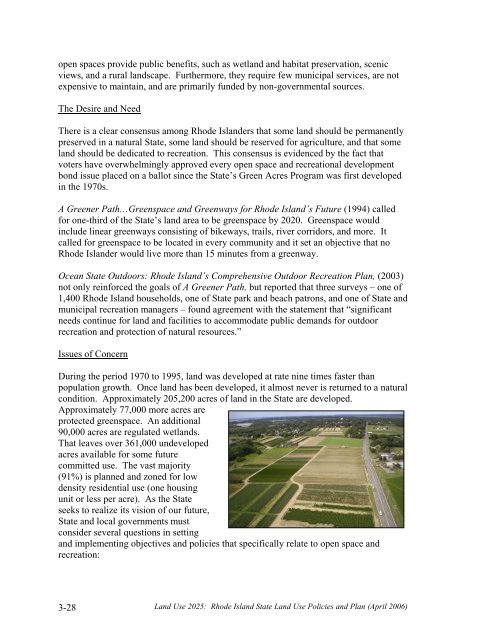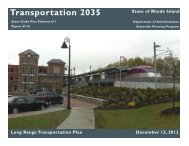Land Use 2025 - RhodeMap RI
Land Use 2025 - RhodeMap RI
Land Use 2025 - RhodeMap RI
- No tags were found...
You also want an ePaper? Increase the reach of your titles
YUMPU automatically turns print PDFs into web optimized ePapers that Google loves.
open spaces provide public benefits, such as wetland and habitat preservation, scenicviews, and a rural landscape. Furthermore, they require few municipal services, are notexpensive to maintain, and are primarily funded by non-governmental sources.The Desire and NeedThere is a clear consensus among Rhode Islanders that some land should be permanentlypreserved in a natural State, some land should be reserved for agriculture, and that someland should be dedicated to recreation. This consensus is evidenced by the fact thatvoters have overwhelmingly approved every open space and recreational developmentbond issue placed on a ballot since the State’s Green Acres Program was first developedin the 1970s.A Greener Path…Greenspace and Greenways for Rhode Island’s Future (1994) calledfor one-third of the State’s land area to be greenspace by 2020. Greenspace wouldinclude linear greenways consisting of bikeways, trails, river corridors, and more. Itcalled for greenspace to be located in every community and it set an objective that noRhode Islander would live more than 15 minutes from a greenway.Ocean State Outdoors: Rhode Island’s Comprehensive Outdoor Recreation Plan, (2003)not only reinforced the goals of A Greener Path, but reported that three surveys – one of1,400 Rhode Island households, one of State park and beach patrons, and one of State andmunicipal recreation managers – found agreement with the statement that “significantneeds continue for land and facilities to accommodate public demands for outdoorrecreation and protection of natural resources.”Issues of ConcernDuring the period 1970 to 1995, land was developed at rate nine times faster thanpopulation growth. Once land has been developed, it almost never is returned to a naturalcondition. Approximately 205,200 acres of land in the State are developed.Approximately 77,000 more acres areprotected greenspace. An additional90,000 acres are regulated wetlands.That leaves over 361,000 undevelopedacres available for some futurecommitted use. The vast majority(91%) is planned and zoned for lowdensity residential use (one housingunit or less per acre). As the Stateseeks to realize its vision of our future,State and local governments mustconsider several questions in settingand implementing objectives and policies that specifically relate to open space andrecreation:3-28<strong>Land</strong> <strong>Use</strong> <strong>2025</strong>: Rhode Island State <strong>Land</strong> <strong>Use</strong> Policies and Plan (April 2006)
















